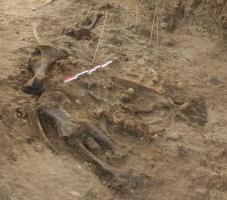 Researchers have dated stone tools and bones from a butchered rhinoceros and other ancient fauna found in the Philippines’ northern island of Luzon, that date back over 700,000 years, or several hundred thousand years before modern man evolved. So far no human bones have been discovered, but as reported in a recent report in the journal Nature, recent excavations in the Cagayan Valley of northern Luzon in the Philippines that have yielded 57 stone tools associated with an almost-complete disarticulated skeleton of Rhinoceros philippinensis, which shows clear signs of butchery, together with other fossil fauna remains attributed to stegodon, Philippine brown deer, freshwater turtle, and monitor lizard.
Researchers have dated stone tools and bones from a butchered rhinoceros and other ancient fauna found in the Philippines’ northern island of Luzon, that date back over 700,000 years, or several hundred thousand years before modern man evolved. So far no human bones have been discovered, but as reported in a recent report in the journal Nature, recent excavations in the Cagayan Valley of northern Luzon in the Philippines that have yielded 57 stone tools associated with an almost-complete disarticulated skeleton of Rhinoceros philippinensis, which shows clear signs of butchery, together with other fossil fauna remains attributed to stegodon, Philippine brown deer, freshwater turtle, and monitor lizard.
The discovery raises many questions. Who were these early hunters? When did they arrive in the Philippines? How did they cross the seas to reach the islands? Because Homo sapiens, or modern man, did not arrive until around until around 300,000 years ago, the rhino hunters on Luzon were most likely Homo erectus, the first the first hominin believed to have ventured out of Africa.
But how did early man travel across the oceans to Luzon? Similar questions have been raised regarding Homo floresiensis, Flores Man, an extinct species of hominid discovered in 2003 on the island of Flores in Indonesia, who may have arrived even earlier than the hunters of Luzon. Because Flores Man stood at only about one meter or around three feet tall, the species has been nicknamed, hobbit.
One of the standard hypothesis to explain how early man traveled across oceans is that groups were carried out by a tsunami or on rafts of vegetation following a typhoon. Modern typhoons and tsunamis, however, are not notably effective as modes of transportation. Slowly, the possibility that early humans piloted boats and ships is become somewhat more accepted in the academic community. The recent paper announcing the Luzon discovery, for example, ends by noting :
“Despite the current evidence, it still seems too farfetched to suggest that H. erectus, or another unknown Pleistocene ancestral candidate for the Kalinga toolmakers (for example, Denisovans27), were able to construct some sort of simple watercraft and deliberately cross sea barriers to reach these islands. However, considering evidence of overseas dispersal during the Middle Pleistocene stage is increasing in number such a hypothesis cannot currently be rejected.”
See also our post from February: Was Homo Erectus the First Sailor? Did Ancient Sailors Tell Sea Stories?

Read it, but didn’t think you’d be interested.
To get there needs some sort of vessel that in in itself would need knots & cordage , our had skills go back much further that we realize